Sitka Has Been Powered by Hydroelectricity for Over 100 Years!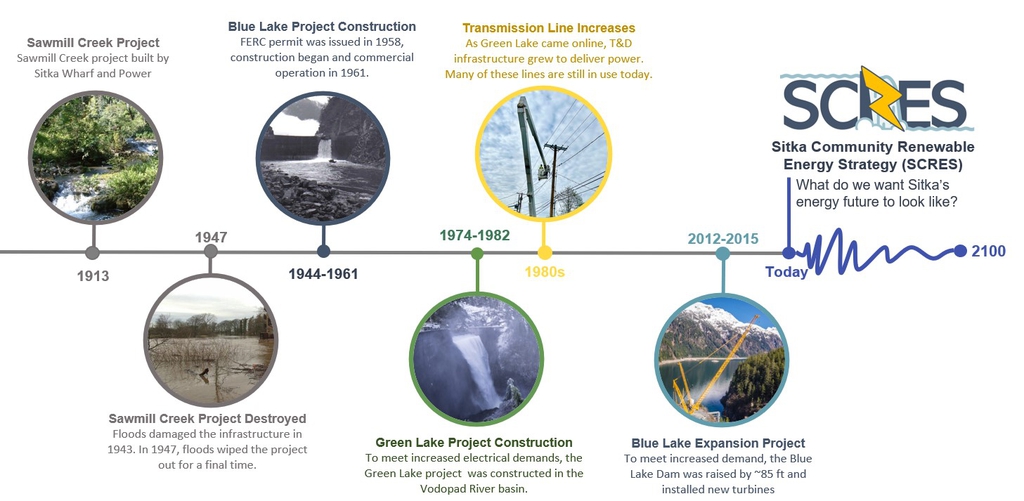 |
For over a century, Sitka has been powered by hydroelectric electricity. Originally built because of the plentiful resource of rain, Sitka had a fortunate head start when it comes to renewable energy but as electrification continues and loads increase Sitka is once again at decision point to determine what comes next in terms of energy. Fortunately, we can learn a lot from the past as we ask ourselves what we want for the future. |
1913-1947 | 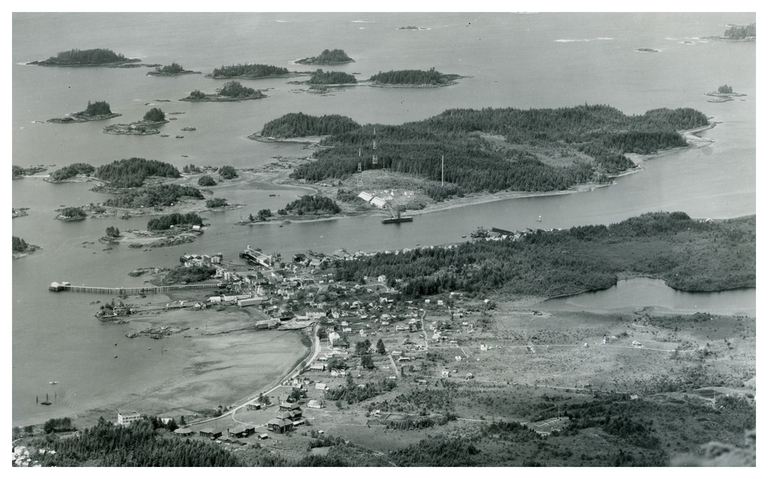 Sitka from Mt. Verstovia in 1933. Image reference: Sitka Maritime Heritage Society Sitka from Mt. Verstovia in 1933. Image reference: Sitka Maritime Heritage Society 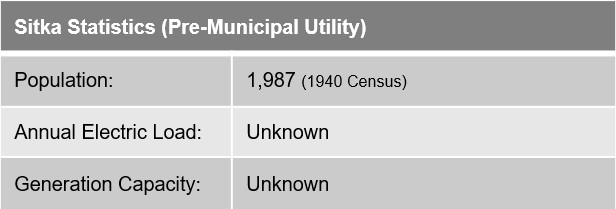 |
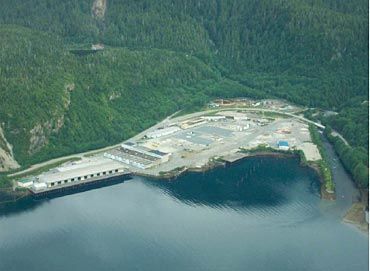 Aerial view of Herring Cove, the former site of the Alaska Pulp Mill, 2004. | 1944-1957 The Blue Lake Project Design 1944 The initial planning for the Blue Lake Project began with 1948 designs placing the powerhouse at Herring Cove. 1956 Engineers Carey and Kramer began incorporating the concept of a pulp mill into the designs. The community voted 241-6 to issue a $6 million bond to fund construction but could not find buyers. 1957 A license application was submitted to the Federal Energy Regulatory Commission (FERC) with a $4.9 million estimate. Alaska Lumber and Pulp (AL&P) (later Alaska Pulp Corporation) required water for the mill, agreed to build a portion of the penstock tunnel and purchased $2.2 million in bonds which the City was struggling to sell. |
1958-1961 The Blue Lake Project Construction 1958 The FERC license was issued was issued on a three phase construction plan: Phase I Initial 35 ft dam and penstock tunnel 1959 |  The Blue Lake Project Phase I: A 35 ft tall dam an underground penstock tunnel, circa 1960. The Blue Lake Project Phase I: A 35 ft tall dam an underground penstock tunnel, circa 1960.
| |
 The Green Lake Hydroelectric Project, circa 1982
| 1974-1982 The Green Lake Project The Green Lake Hydroelectric Project design began in when annual loads were approaching the 60 GWh maximum capacity and a series of series of dry years made Sitka's ability to meet demand uncertain. 1974Initial project design began and was estimated to cost $21 million. 1977 The community voted 1540-89 to move forward with construction of the project. 1979 A license application was submitted to FERC with an estimated cost of $42 million. To help fund the project, the City increased rates 25% (from 8c/kWh to 10c/kWh ) and another 20% (10c/kWh to 12c/kWh) in 1980. Since Green Lake would take load off of Blue Lake, AL&P signed a surplus power sales agreement due to their need for water. This prevented the need for the City to raise the rates by 65% (from 10c/kWh to 16.5c/kWh). 1980 The main transmission line was upgraded from 34.5kV capacity to 69 kV to account for Blue Lake and the added Green Lake generation capacity. 1982 The Green Lake Hydroelectric Project was completed for $76 million. The Green Lake Project included 2 new 9 MW turbines which added 58 GWh of generation, doubling Sitka's annual capacity. |
1990 - Present Fish Valve Unit: A Small Hydroelectric Project To allow for power generation off water required to be released to maintain healthy salmon habitat in Sawmill Creek, CBS proposed putting in a small turbine in between the Blue Lake dam and powerhouse. This was called the Fish Valve Unit (FVU). 1990 A license was submitted to FERC with a project estimate of $3.9 million. 1992 FVU was built for $4.7 million. 1994 FVU was flooded and damaged by Sawmill Creek. 2014 The FVU was rebuilt as part of the Blue Lake Expansion (below). | 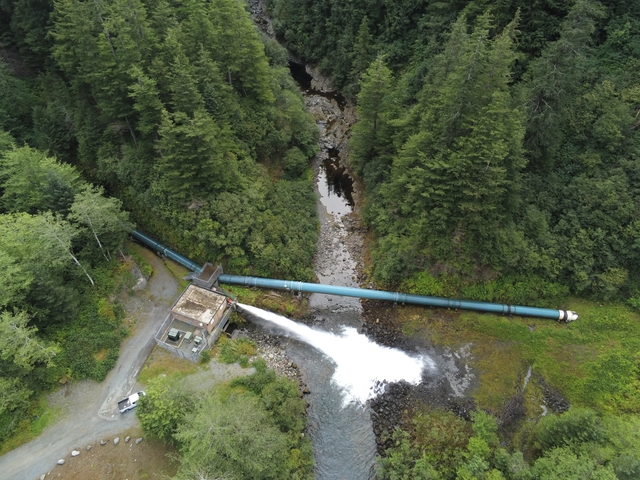 The Fish Valve Unit, 2019. Water is required to be released to maintain salmon habitat. Rather than discharging directly, water passes through a small turbine before entering Sawmill Creek. The Fish Valve Unit, 2019. Water is required to be released to maintain salmon habitat. Rather than discharging directly, water passes through a small turbine before entering Sawmill Creek. | |
 The Blue Lake Dam under construction in 2013. The original spillway can still be seen today.
| 2007-2015 The Blue Lake Expansion Following increasing fuel oil prices and consistent annual energy load increases in Sitka, it was clear that a more robust and lasting energy system was needed to meet demands long-term. 2008 Plans and permits to raise the dam were submitted to FERC in when the initial 50 year Blue Lake Project license was set to expire. The initial cost was estimated at $100 million. 2010 CBS aimed to fund 50% of the project with grants and started looking for funding which was a significant challenge. The same year, the community voted 2595-373 to sell $50 million in bonds to fund the project. 2012 The FERC license was issued and general construction bids estimated the project to cost $145 million. The City issued additional bonds to cover the gap. 2014 The project was completed for $154 million and included:
The Blue Lake Expansion came fully online in early 2015, doubled the hydroelectric project's capacity to 15.9 MW and increased Sitka's total annual generation capacity 30% to ~160 GWh. |
2020 CBS Assembly reestablished the Climate Action Task Force. 2022 The Climate Action Task Force sunset after recommending the establishment of a permanent Sustainability Commission to carry on the work and hire a Sustainability Coordinator to help make CBS more sustainable. 2023 The Sustainability Commission recommended CBS develop a community renewable energy strategy with help from the Energy Transitions Initiatives Partnership Project (ETIPP) program. With Assembly approval, CBS applied and was selected! 2024 The Sustainability Commission established the scope of the Sitka Community Renewable Energy Strategy to include:
|
How Does Sitka Get Started?The SCRES is an ongoing project, the best thing you can do is keep learning about energy through the SCRES site and sign up to get updates as new pages are made and workshops are scheduled. | |||||||
|
| ||||||
Prefer to Watch? |
This page was last updated November 12, 2024. |